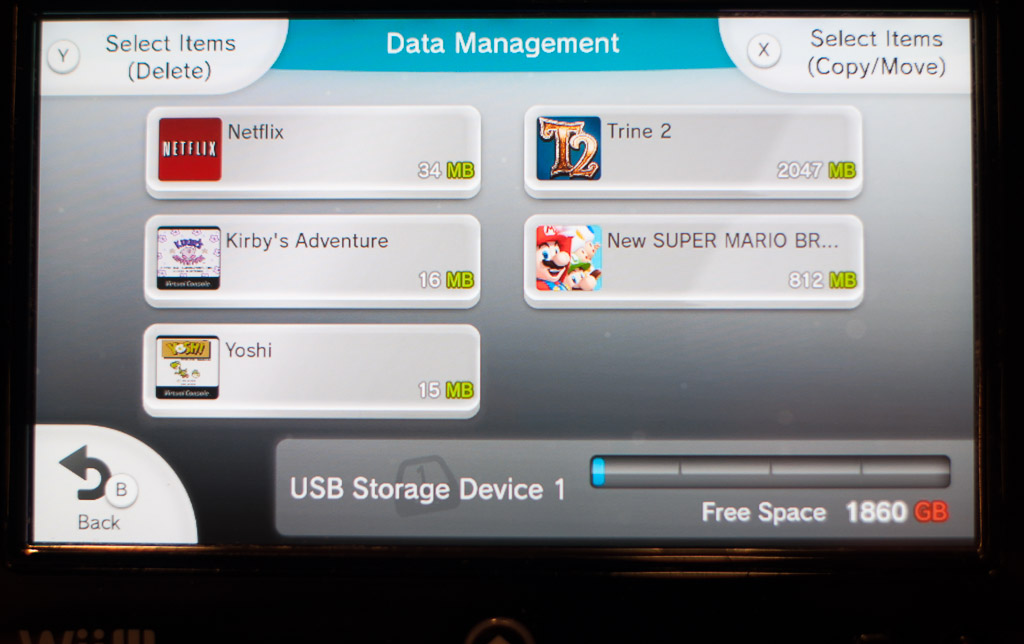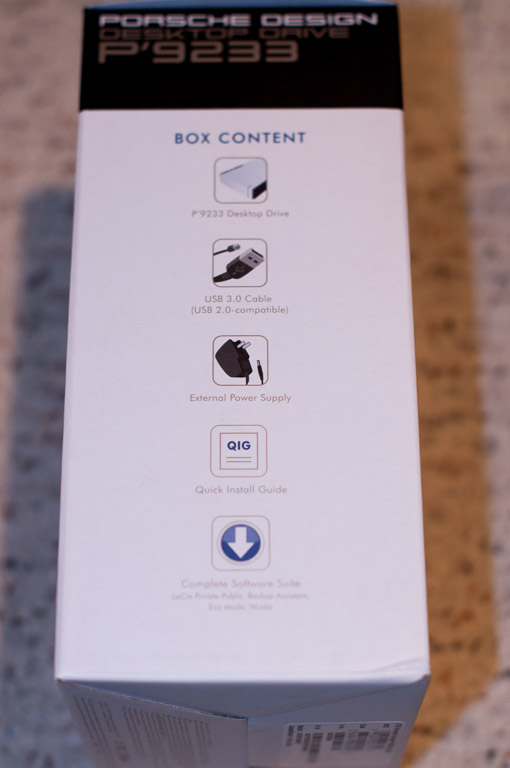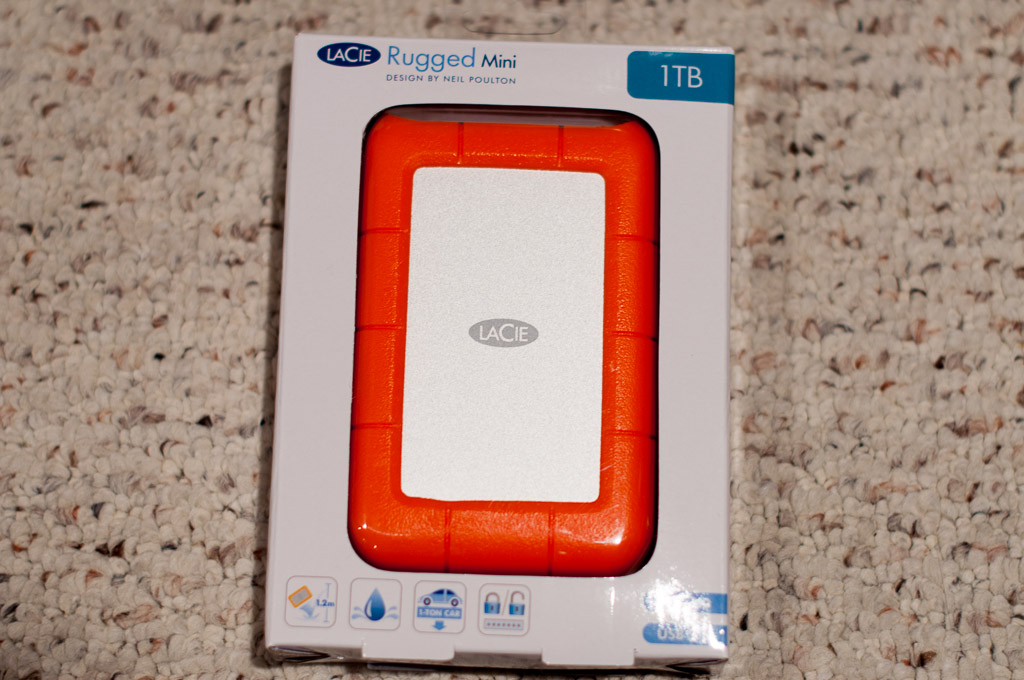Wii U External USB Storage Reviews
When Nintendo first announced that they were planning on adding external Hard Disk Drive (HDD) support to the Wii U, we wanted to find out exactly which drives will work with the Wii U console, and which ones perform best.
Nintendo has published an official list of supported External USB Storage devices, but it doesn’t give you an idea of exactly how each of these drives compare to each other or how they interoperate with the Wii U console.
Nintendo also outlines on their external storage FAQ that your external storage device should use a dedicated power supply. Nintendo also states in the FAQ that they do not recommend using USB thumb drives because of their limited read/write cycles, but they do not outright state that it won’t work.
So, we contacted several manufacturers, including a couple of those not listed on the Supported Device list to see if they would be interested in submitting drives for review. As of press time, only one manufacturer agreed to send us sample units. We will update this article as additional manufacturers supply us with sample units.
[divider] Methodology and Setup [/divider]Testing Methodology
We chose to test several common scenarios that an individual might run through when attaching external storage to their Wii U. These scenarios included formatting of the storage, moving data to and from the Wii U console, and starting up games and applications.
We used the Stopwatch within the Android Clock app on a Galaxy S III. We pressed “Start” at the same time as we selected the icon on the Wii U GamePad.
Per Nintendo’s requirements, we connected and disconnected each device only when the Wii U was off. Only one device was connected at a time, to avoid any possible crosstalk or USB bus impact by having multiple devices connected.
Testing Equipment Setup
Each drive was tested individually against a Wii U 32GB Deluxe console with v3.01U firmware. The Wii U was connected via HDMI to a Yamaha RX-A3000 receiver, which is in turn connected to a Panasonic Viera TC-P65VT30 plasma TV via HDMI.
Tested Games and Apps
Generally, external storage will be used for expansion once your Wii U begins to run low on internal storage. This is likely to occur due to full games and apps downloaded from the eShop. As such, we decided to exclusively test electronically downloaded content.
- Trine 2: Director’s Cut
- Kirby’s Adventure
- Yoshi
- Netflix
- New Super Luigi U
Total data among all five of these titles was approximately 3.0GB in size.
[divider]The Contenders[/divider] [expand title=”LaCie”] [expandsub1 title=”2TB Porsche Design Desktop Drive P’9233″]http://www.lacie.com/us/products/product.htm?id=10587

The LaCie P’9233 is a very well-designed and thought out product. It is simple and easy to use, and the unboxing experience is unlike many other USB drives I’ve worked with in the past.
http://www.lacie.com/us/products/product.htm?id=10564

The Rugged Mini is just that – rugged. The drive is surrounded with a durable, rubbery silicon case, similar to what you might find in high-end cell phone cases.

[/expandsub1] [/expand] [divider] The Tests [/divider]
[expand title=”The Format Test”]
In this test, we attached an unformatted device to the Wii U and used its internal format routine.
[expandsub1 title=”LaCie 1TB Rugged Mini”]Result: FAIL
Nintendo’s recommendation for external storage with its own power supply rang true with the LaCie Rugged Mini. When we connected the LaCie Rugged Mini, the Wii U reported “The device could not be formatted.” The hard drive spun up, stayed running for a second, then spun down repeatedly. We wondered if the drive was faulty, so we attempted to connect it to several different Windows PCs, on which it worked just fine. I suspect the reason for Nintendo’s recommendation is because they are not providing enough voltage across the USB ports to power a single standalone 2.5″ drive. It would be interesting to put a multimeter on the Wii U’s USB ports to find out exactly how much voltage is being provided and even more interesting to find out why Nintendo chose not to go with a standard USB-spec port.
[/expandsub1] [expandsub2 title=”LaCie 2TB Porsche Design Desktop Drive P’9233″]Result: PASS
The LaCie 2TB Porsche Design Desktop Drive P’9233 completed its format in 4.59 seconds. No anomalies occurred during the format.
[/expandsub2] [expandsub3 title=”Corsair 8GB Flash Voyager USB 3.0″]Result: PASS
The Corsair 8GB Flash Voyager completed formatting in 3.32 seconds, which is not surprising considering its relatively diminutive size compared to the LaCie 2TB drive.
[/expandsub3] [/expand][expand title=”Moving data from Wii U internal storage to external storage”]
In this test, we used the Wii U data transfer utility to move data from the Wii U internal storage to the external storage device.
Result: Not tested
Because the LaCie Rugged Mini could not be formatted when attached to the Wii U, no further tests could be performed on it.
[/expandsub1] [expandsub2 title=”LaCie 2TB Porsche Design Desktop Drive P’9233″]Result: COMPLETE, 4 minutes 06 seconds
The 3GB of data moved from internal Wii U storage to LaCie 2TB Porsche Design Desktop Drive P’9233 in four minutes and six seconds.
[/expandsub2] [expandsub3 title=”Corsair 8GB Flash Voyager USB 3.0″]Result: COMPLETE, 7 minutes and 06 seconds
The Corsair 8GB Flash Voyager was much slower than the LaCie 2TB drive. This is likely due to the slower write speed and lack of internal cache on the thumb drive compared to the LaCie drive.
[/expandsub3] [/expand][expand title=”Moving data from external storage back to the Wii U internal storage”]
In this test, we used the Wii U data transfer utility to move data from the external storage device back onto the Wii U internal storage.
[expandsub1 title=”LaCie 1TB Rugged Mini”]Result: Not tested
Because the LaCie Rugged Mini could not be formatted when attached to the Wii U, no further tests could be performed on it.
[/expandsub1] [expandsub2 title=”LaCie 2TB Porsche Design Desktop Drive P’9233″]Result: COMPLETE, 6 minutes and 27 seconds
The LaCie 2TB Porsche Design Desktop Drive P’9233 moved the 3GB of data back to the Wii U internal storage in six minutes and twenty-seven seconds. This is an interesting result, because it begins to illustrate a bias of reads to writes in the Wii U internal storage. Is this as fast as the Wii U can write data to its internal memory via USB?
[/expandsub2] [expandsub3 title=”Corsair 8GB Flash Voyager USB 3.0″]Result: COMPLETE, 7 minutes and 23 seconds
Another interesting result. We never expect USB thumb drives to be that fast, but we were surprised that it took an additional 56 seconds to complete the 3GB data move back to Wii U internal storage. This is likely a result of limited read speed from the Corsair Flash Voyager.
[/expandsub3] [/expand][expand title=”Starting a title to its first user-interactive screen”]
In this test, we launched a title from the Wii U GamePad and timed how long it took to get to the first user-interactive part of the game, such as a “Press + to start” screen. The times below include fully playing through any introductory title screens without interruption. Each test was performed three times to make sure we had consistent data.
[expandsub1 title=”New Super Luigi U”]We tried to find a way to time New Super Luigi U starting up, but because it is tightly integrated with New Super Mario Bros. U, we were unable to test properly. Our NSMBU copy is disc-based, and the experience to get into NSLU is simply choosing the “Switch to New Super Luigi U” button at the top of the NSMBU menu screen. Therefore, we only used this title to assist in the data transfer tests.
[/expandsub1] [expandsub2 title=”Trine 2: Director’s Cut”] [easychart type=”horizbar” title=”Trine 2: Director’s Cut Startup Times” groupnames=”Wii U Internal,LaCie P’9233,Corsair Flash Voyager” groupcolors=”000000,229944,0066CC” valuenames=”Run 1,Run 2,Run 3,Average” group1values=”56.78,51.5,54.08,54.12″ group2values=”40.84,41.68,43.43,41.98″ group3values=”42.79,42.48,40.44,41.90″ ] [/expandsub2] [expandsub3 title=”Kirby’s Adventure (Virtual Console)”] [easychart type=”horizbar” title=”Kirby’s Adventure Startup Times” groupnames=”Wii U Internal,LaCie P’9233,Corsair Flash Voyager” groupcolors=”000000,229944,0066CC” valuenames=”Run 1,Run 2,Run 3,Average” group1values=”14.87,13.64,14.73,14.41″ group2values=”10.8,12.03,11.13,11.32″ group3values=”10.23,10.67,11.43,10.78″ ] [/expandsub3] [expandsub4 title=”Yoshi (Virtual Console)”] [easychart type=”horizbar” title=”Yoshi Startup Times” groupnames=”Wii U Internal,LaCie P’9233,Corsair Flash Voyager” groupcolors=”000000,229944,0066CC” valuenames=”Run 1,Run 2,Run 3,Average” group1values=”13.89,13.49,16.42,14.6″ group2values=”10.87,10.84,10.26,10.66″ group3values=”11.1,11.07,10.31,10.83″ ] [/expandsub4] [expandsub5 title=”Netflix”] [easychart type=”horizbar” title=”Netflix Startup Times” groupnames=”Wii U Internal,LaCie P’9233,Corsair Flash Voyager” groupcolors=”000000,229944,0066CC” valuenames=”Run 1,Run 2,Run 3,Average” group1values=”23.71,22.57,22.33,22.87″ group2values=”17.39,18.41,19.1,18.3″ group3values=”17.18,18.51,18.66,18.12″ ] [/expandsub5] [/expand][expand title=”Conclusions”]
We have some very interesting results here. It’s obvious that the Wii U storage performance is not anywhere near where we think it should be for flash-based storage. Obviously since Nintendo doesn’t officially support using USB thumb drives we can’t declare a winner.
We have to call out Nintendo to work on improving performance of the Wii U internal storage. We’re not sure what exactly the performance specs are for the internal storage, but it’s obvious that when a $15 retail thumb drive can outperform a $350 next-gen console, there is a serious issue to be addressed.
If you’d like to see any other comparison tests performed, please leave a comment in the section below.
[/expand]Review and tests performed by J. Casalino (j@purenintendo.com, Twitter:@J_Casalino)
If you’re an external storage device manufacturer and you’d like us to test your device and add it to the above review, please contact us via e-mail or Twitter to make arrangements.










July 24, 2013
I use a old Maxtor 320.GB which works perfect on Wii U. I would guess that any external HD brand would work. If its a brand that dont work, it must be Iomega. Iomega drives even struggle to work with PC.